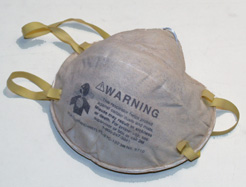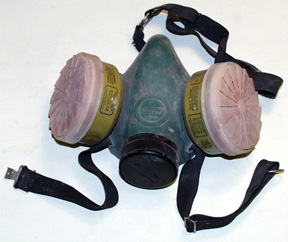Respirators
![]()
Respirators |
|
by Steven C. Wieczorek
|
This article appeared in the June 1987 Falco Builders Letter. Steve Wieczorek is Senior Engineer for Finishes, Materials and Processes at Sikorsky Aircraft. |
I want to persuade all Falco builders to use air filtration respirators during sawing and sanding of wood, and during painting. I can hear the complaining already. Yes, a few of you out there have built several airplanes and have gotten away without using any type of breathing protection. So, why should I use something that is heavy, tight-fitting, cumbersome, and a general pain-in-the-neck to wear?
Doctors trying to stop the spread of AIDS face a similar problem with African tribesmen, who don't believe that you get it from sex because they never got AIDS before.... So it is with painters who have sprayed for years without any serious problems, but epoxies and polyurethanes are very dangerous. I know a painter who didn't believe in masks and started shooting polyurethanes. One day the man collapsed, was rushed to a hospital and today this 45-year-old man is on life-support oxygen-he carries a bottle at all times. The condition is permanent and will never improve. Do I have your attention?
First let's take a look at wood dust. Wood dust has been considered to be an unpleasant but unavoidable aspect of building a wood airplane. In industrial/commercial facilities, vacuum filters are often connected to power saws and sanders. But in our home workshops, where in most cases we don't have these vacuum filters, we still find ourselves breathing more wood than we like, producing symptoms of sneezing, coughing, runny nose and phlegm. To some degree these are natural reactions, as the body traps and moves dust up and out of the respiratory tract. But the body's defenses can be overloaded.
Just how hazardous is this dust? Inorganic dusts from coal, silica and asbestos have long been known to provoke serious lung damage. Recent research strongly suggests that the relatively large-sized particles generated by sawing or sanding wood also pose a threat, not to the lungs but to the upper respiratory tract. A report in the British Medical Journal described an unusually high rate of nasal cancer among furnituremakers in the Oxford area. This disease occurs in only 6 out of 10,000,000 people among the general population each year, compared to 7 out of 10,000 among the furnituremakers, often in factories lacking dust-collection systems. The disease was not found in wood finishers, who typically work in separate shops, suggesting that nasal cancer is linked to dust rather than to chemical exposure. Neither were high cancer rates found among carpenters, who worked mostly outdoors where dust doesn't persist. I'm not suggesting that you will get cancer if you don't wear a mask, but you should be aware of the potential danger.
There are three ways to reduce your exposure to dust. In some situations you can choose another tool that produces less dust-a plane, for example, can be substituted for a belt sander. Second, you can trap the dust at the source, using vacuum collection. Adequate ventilation is the best defense against respiratory dangers, but for those who won't or can't spend the money for a dust-collection and ventilation system, the third alternative is to wear a mask.

A typical "nuisance dust" mask
Many woodworkers use "nuisance dust" masks, which are designed to trap large diameter, non-toxic particulates. These masks offer fairly good protection for general woodworking, but they are inadequate for dusts released from home insulation, chemically treated lumber, or allergenic species of wood.
Given the new-found danger of wood dust, it is better to use what the National Institute of Occupational Safety and Health (NIOSH) approves as a "toxic-dust" mask, which provides about twice the filtration efficiency of nuisance dust masks. NIOSH-approved disposable toxic-dust masks include 3M's model 8710 and Norton's model 7170, which can be purchased locally from a building supply retailer.

A well-used Norton respirator.
To provide yourself with the best possible protection, I recommend you use a NIOSH-approved toxic-vapor respirator. One of the best-and most comfortable-toxic-vapor respirators is the 3M 7200S (small-medium)/7300S (medium-large) Dual Cartridge, Half-Mask Respirator, Facepiece-Silicone. This respirator is designed to be used with several different types of pre-filters and disposable filter elements. This is the mask we use at Sikorsky, and I recommend that you use it, too.
For sanding and sawing of wood, sanding of polyurethane, epoxy, lacquer, enamel, organic vapors and dusts, fumes and mist, use the following filter arrangement: 3M 7200S/7300S Respirator with 7255 High Efficiency Filter, 7251 Organic Vapors Cartridge and 7287 Cartridge Retainer. This filter/cartridge arrangement is to be used for sanding and sawing of the above materials only, and is not to be used for spraying of any paints or topcoats-those filters are discussed below.
Painting is one of the most satisfying and rewarding aspects of building a Falco; however, the use of a respirator is absolutely essential for your good health. Many paints, thinners, and cleaning solutions you use are poisonous, and you can get sick unless you take adequate precautions to avoid breathing the vapors. Some spray painters neglect to wear proper respiratory protective equipment because they have never noticed immediate bad effects from exposure to vapors which they have been told are harmful. This practice could permanently damage your health before the effects become noticeable, then it is too late.
Isocyanates, which are used as a solvent in some primers and most polyurethane topcoats, may irritate the respiratory tract of individuals coming into contact with the vapor or spray mist. To prevent this, always use a respirator. Symptoms of this irritation may include watering of the eyes and a burning sensation in the nose and throat. The severity of the irritation depends on the individual and the degree of exposure.
Isocyanates may also cause a sensitization response in some individuals. The sensitization response can range from a mild wheezing to a severe asthmatic type attack. You are considered to be sensitized to isocyanates if you respond to airborne isocyanate levels much lower than those which cause an irritation response in most people. You may become sensitized after a trouble-free period of exposure. Sensitization is a permanent condition, so sensitized individuals should be permanently removed from all further contact with isocyanates.
Volatile organic solvents, used in some primers and most polyurethane topcoats, may also cause irritation of the respiratory tract or acute nervous system depression characterized by headache, dizziness, staggering gait or confusion.
Exposure to extremely high airborne solvent levels such as those found in confined spaces may lead to unconsciousness, coma or death. Some reports have associated prolonged and repeated occupational overexposure to solvents with permanent brain and nervous system damage. Effects include concentration difficulties, diminished manual dexterity and memory loss. It should be noted that the above comments apply to organic solvents in general, not only to those used in aerospace coatings.
I should explain that epoxies and polyurethanes attack your body in two distinct and separate ways. Sensitization is a condition whereby the chemical compounds enter your system through your lungs or skin-isocyanate solvents penetrate the skin quite easily-and cause a change in the cells of your body which brings about the allergy-like reactions. With epoxies, the onset of sensitization is often very sudden. With isocyanates, some of the symptoms, like a change in personality, appear gradually.
The other is what I will call lung-coating. Whenever you work with epoxy or polyurethanes, microscopic liquid particles settle on the membranes of the lungs, attach themselves and harden. These particles are not bio-degradable, and they remain with you for the rest of your life. They physically block the absorption of oxygen. This lung-coating occurs even when you are working with epoxy resins with a brush although very little damage occurs from occasional use. The serious lung-coating damage comes from spraying epoxy primers and polyurethane topcoats and breathing this mist. (Dust from sanding cured epoxies and polyurethanes is chemically inert and is expelled by your lungs like ordinary dust of wood, soil, etc.)
With lung-coating, some damage occurs every time you breath the paint spray. Some people develop a shortness of breath before a complete collapse, but most often the onset of the symptoms is sudden, like that of my friend who now carries an oxygen bottle. Thus, the damage is progressive, and you can be tricked into thinking you're fine until suddenly it's all over.
People who get into trouble with epoxy resin usually become sensitized. This means they can no longer work with epoxies, but otherwise can lead normal lives. Painters who get into trouble usually do so from lung-coating, and this permanent damage remains with them until their life's end or lung transplant. Painters may also be sensitized and their personality may be permanently altered, but this is a minor inconvenience compared to the damage created by lung-coating.
For spraying polyurethane, epoxy, lacquer, enamel, or working in an environment of organic vapors, dusts and mists, use the following respirator and filter arrangement: 3M 7200S/7300S Respirator with 7256 Spray Paint Pre-Filter, 3M 7251 Organic Vapors Cartridge, and 3M 7287 Cartridge Retainer. Note that this is exactly the same respirator but with only one change in the filters. Again, this is what we use at Sikorsky.
For the name of a distributor near you, contact Occupational Health & Safety Products Div/3M, 220-7 W 3M Center, St. Paul, MN 55101. Telephone (612) 733-8029. 3M says that Sears sells their painting respirators, but unfortunately I don't know what the equivalent part numbers are.
I hope I haven't painted a gloomy picture for you. I do hope I've impressed upon you the necessity of using safety precautions when working with modern state-of-the-art materials. Remember, we ultimately want to enjoy for many years the fruits of our labor... and the way I spell that is F-A-L-C-O!